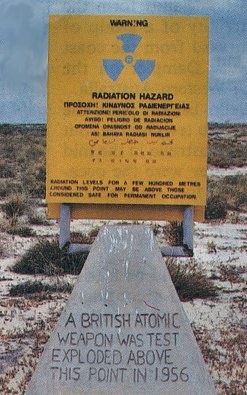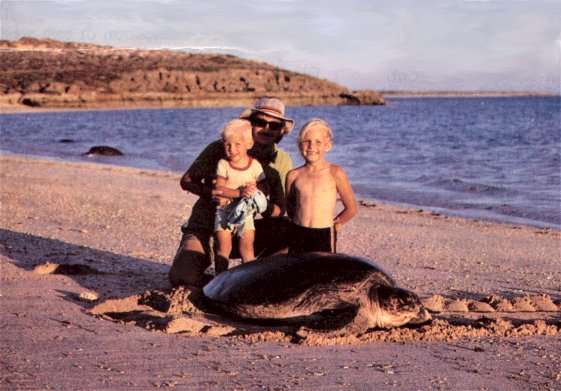from Rob Legg Yachts |
|||||
The Monte-Bellos… The A-Bomb islands of the North WestPart 5 - A DAY ON THE ISLANDS
In the Monte Bellos the only reply is "Coral trout!" "But we haven't any left", comes back an unhappy voice. Cast off anchors ... throw lure over stern ... motor towards the gap between Alpha and Bluebird Island (just over half a mile away) and two good sized Coral trout supply more than the greedy appetites can manage for breakfast, not to mention the two 15-20 kg mackerel that joined ship between the Coral trout but were released. And those Coral trout! The best fish in the world. Their soft white flesh just melts in the mouth, even surviving Nigel's liberal application of barbeque sauce. After breakfast it is a toss up whether to go diving, swimming or chase a few real big ones with the game rods, go for a walk, or just lie back and savour the glory of it all. Peace. Only broken by the distant (hopefully) shouts of the children and the cry of the osprey sea eagles as they hunt for their breakfast too. Nary a cloud in the sky as we sailed down the west side of island after island. Occasionally the wind would die completely and we would motor for a while. With an old blanket over the outboard, things weren't too noisy and it saved running the Honda generator. By 1400 hours we were nearing the deep water between Barrow Islands and the lower shoals of the Monte Bellos but the sudden appearance of large swells around us, breaking in places, encouraged a change of course eastwards in 10 feet of water to the Lowendal Islands. There are a number of comfortable anchorages in the Lowendals, particularly in the north-eastern end. These islands are only two miles long but are well worth a visit. The next day was sheer hell as we drifted back with the spinnaker up making three to four knots, with Nigel and myself reclining in deck chairs on the cabin roof out of the sun with a cold can in hand, all too frequently interrupted by the scream of a reel as another fish tried its luck. Apart from those required for the table, all others were carefully released. It would take a book to tell all there is to tell of the Monte Bello Islands. It's a place that has to be visited to capture the full impact of its stark beauty. But while you are there in mind, we had better show you the safe entrance and exit points to the inner delights that have been mentioned. First of all, there is no access through the western reef to the islands. Some fishermen mutter about a gap in the reef but that local bit of knowledge has not been unearthed as yet. There are two safe entrances for yachts of any size.

The second passage is a bit harder to find initially but is well worth the effort. Start from the little islands a mile south-east of Southeast Island, head west towards a bald hill island with a 12 foot pole on its top and a round flat rock on its right. There's plenty of water through here but some of the adjacent gaps can lead to trouble. Time for another word of warning. Tides run to over four metres in this region and although the weather is generally kind, a first requirement is a decent engine to push against the tide. Our only problem during our stay was limited to our three metre inflatable's outboard giving up the ghost early in the piece. As it is hard to row a loaded dinghy against the flush of a full ebb tide, this is one reason we liked the Alpha Island anchorage so much, as it was current free. The loss of the outboard wasn't that much of a hardship as, with the yacht's keel retracted and the boat only drawing 16 inches, we could go almost anywhere the dinghy could anyway. The return to civilisation in each trip was the reverse of the arrival. The first cruise with Joe saw a daylight passage of the Mary Anne Passage with a most definately not recommended night arrival in Onslow. The lead lights marked on the chart for the entrance to Onslow haven't been visible for years according to local fishermen and the only one we could see was the little two mile light at the entrance to Beadon Creek. Happily, conditions were perfect and we saw the light through the binoculars 10 miles out, so with a careful watch on the DR plot and a wary eye on the echo sounder, we were reasonably happy but I wouldn't do it again. The departure for Dampier was at 2200 hours after a pleasant tea preceded by a walk up the eastern beach of North West Island to watch the scores of turtles frolic in the shallows and crawl up the beach to lay their eggs. The children were fascinated by this further display of the marvels of nature but were saddened to see the harsher side of that same nature with the discovery of a number of skeletons of these bulky creatures. These unfortunates had apparently mistaken the sound of the surf on the ocean side as the nearest water after their exhausting labours, only to become lost in the sandhills and scrub to die a slow death from the sun and thirst. Such a superb night for a sail could not be spoiled by such realities however, so as the two lighthouses of the Monte Bello Islands dipped their blinking heads below the horizon, the children gradually dropped off to sleep to store away lifelong memories of the superb fortnight in the Monte Bello Islands. |

